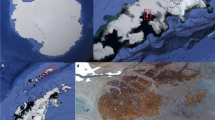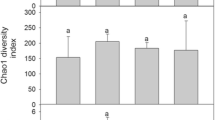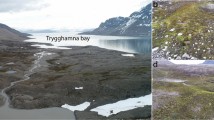Abstract
Little is known in continental Antarctic about patterns of abundance, diversity, and succession of microfungi within moss profiles consisting of live, senescent, and dead tissues in different stages of decomposition. In the present study, vertical patterns of the abundance and diversity of microfungi and their relationship with chemical compositions were examined within moss colonies collected from coastal outcrops in the Lützow–Holm Bay area (Queen Maud Land), East continental Antarctica. Total and darkly pigmented hyphal length, the richness of molecular operational taxonomic units (MOTUs) of microfungi, and the occurrence of Phoma herbarum and Pseudogymnoascus pannorum increased with the depth of moss profiles. The content of organic chemical components and nitrogen in moss tissues decreased, whereas ash content increased with the depth of moss profiles. Relative amount of recalcitrant compounds and total carbohydrates did not significantly differ among the vertical layers. The downward increase of the microfungal richness and occurrence in the Antarctic moss profiles without MOTU replacement was consistent with the directional-nonreplacement model of succession, indicative of the high environmental resistance, which represents the sum of the adverse factors hindering the success of species establishment. This contrasted with the fungal succession in arctic moss profiles, which accorded with the directional-replacement model, in which species replacement took place due to modification of habitat and competition. More hostile environmental conditions than those in the Arctic characterized the fungal succession and limited the fungal decomposition of moss in continental Antarctica.





Similar content being viewed by others
References
Altschul SF, Madden TL, Schaffer AA, Zhang JH, Zhang Z, Miller W, Lipman DJ (1997) Gapped BLAST and PSI-BLAST: a new generation of protein database search programs. Nucleic Acids Res 25:3389–3402
Arenz BE, Blanchette RA, Farrell RL (2014) Fungal diversity in Antarctic soils. In: Cowan DA (ed) Antarctic terrestrial microbiology. Springer, Berlin, pp 35–53
Bailey AD, Wynn-Williams DD (1982) Soil microbiological studies at Signy Island, South Orkney Islands. Br Antarct Surv Bull 51:167–191
Baker JH (1972) The rate of production and decomposition of Chorisodontium aciphyllum (Hook. f. & Wils.) Broth. Br Antarct Surv Bull 27:123–129
Berg B (1986) Nutrient release from litter and humus in coniferous forest soils—a mini review. Scand J For Res 1:359–369
Berg B, Söderström B (1979) Fungal biomass and nitrogen in decomposing Scots pine needle litter. Soil Biol Biochem 11:339–341
Bridge PD, Newsham KK (2009) Soil fungal community composition at Mars Oasis, a southern maritime Antarctic site, assessed by PCR amplification and cloning. Fungal Ecol 2:66–74
Butler MJ, Day AW (1998) Fungal melanins: a review. Can J Microbiol 44:1115–1136
Cannone N, Convey P, Guglielmin M (2013) Diversity trends of bryophytes in continental Antarctica. Polar Biol 36:259–271
Davey ML, Currah RS (2006) Interactions between mosses (Bryophyta) and fungi. Can J Bot 84:1509–1519
Davis RC (1981) Structure and function of two Antarctic terrestrial moss communities. Ecol Monogr 51:125–143
Domsch KH, Gams W, Anderson TH (2007) Compendium of soil fungi, 2nd edn. IHW-Verlag, Eching
Dowding P, Widden P (1974) Some relationships between fungi and their environment in tundra regions. In: Holding AJ, Heal OW, MacLean SF Jr, Flangan PW (eds) Soil organisms and decomposition in tundra. University of Alaska, Tundra Biome Steering Committee, Fairbanks, pp 123–150
Dubois M, Gilles KA, Hamilton JK, Rebers PA, Smith E (1956) Colorimetric method for determination of sugars and related substances. Anal Chem 28:350–356
Erickson M, Miksche GE (1974) On the occurrence of lignin or polyphenols in some mosses and liverworts. Phytochemistry 13:2295–2299
Fenton JHC (1980) The rate of peat accumulation in Antarctic moss banks. J Ecol 68:211–228
Fernandez CW, Koide RT (2014) Initial melanin and nitrogen concentrations control the decomposition of ectomycorrhizal fungal litter. Soil Biol Biochem 77:150–157
Fukasawa Y, Osono T, Takeda H (2009) Effects of attack of saprobic fungi on twig litter decomposition by endophytic fungi. Ecol Res 24:1067–1073
Gardes M, Bruns TD (1993) ITS primer with enhanced specificity for basidiomycetes: application to the identification of mycorrhizae and rust. Mol Ecol 21:113–118
Hirose D, Tanabe Y, Uchida M, Kudoh S, Osono T (2013) Microfungi associated with withering willow wood in ground contact near Syowa Station, East Antarctica for 40 years. Polar Biol 36:919–924
Hirose D, Hobara S, Matsuoka S, Kato K, Tanabe Y, Uchida M, Kudoh S, Osono T (2016) Diversity and community assembly of moss-associated fungi in ice-free coastal outcrops of continental Antarctica. Fungal Ecol 24:94–101
Jones PCT, Mollison JE (1948) A technique for the quantitative estimation of soil microorganisms. J Gen Microbiol 2:54–69
Kanda H, Inoue M (1994) Ecological Monitoring of moss and lichen vegetation in the Syowa station area, Antarctica. Proc NIPR Symp Polar Biol 7:221–231
King HGC, Heath GW (1967) The chemical analysis of small samples of leaf material and the relationship between the disappearance and composition of leaves. Pedobiologia 7:192–197
Lehtonen MT, Akita M, Kalkkinen N, Ahola-Iivarinen E, Rönnholm G, Somervuo P, Thelander M, Valkonen JPT (2009) Quickly-released peroxidase of moss in defense against fungal invaders. New Phytol 183:432–443
Leung GL, Robson GD, Robinson CH (2011) Characterisation of cold-tolerant fungi from a decomposing High Arctic moss. Soil Biol Biochem 43:1975–1979
Lindo Z, Gonzalez A (2010) The Bryosphere: an integral and influential component of the Earth’s biosphere. Ecosystems 13:612–627
Malosso E, Waite IS, English L, Hopkins DW, O’Donnell AG (2006) Fungal diversity in maritime Antarctic soils determined using a combination of culture isolation, molecular fingerprinting and cloning techniques. Polar Biol 29:552–561
McRae CF, Seppelt RD (1999) Filamentous fungi of the Windmill Islands, continental Antarctica. Effect of water content in moss turves on fungal diversity. Polar Biol 22:389–394
Miller OK Jr, Laursen GA (1974) Belowground fungal biomass on US tundra biome sites at Barrow, Alaska. In: Holding AJ, Heal OW, MacLean SF Jr, Flangan PW (eds) Soil organisms and decomposition in tundra. University of Alaska, Tundra Biome Steering Committee, Fairbanks, pp 151–158
Ochyra R, Lewis-Smith RI, Bednarek-Ochyra H (2008) The illustrated moss flora of Antarctica. Cambridge University Press, Cambridge
Osono T, Takeda H (2001) Organic chemical and nutrient dynamics in decomposing beech leaf litter in relation to fungal ingrowth and succession during three year decomposition processes in a cool temperate deciduous forest in Japan. Ecol Res 16:649–670
Osono T, Takeda H (2004) Accumulation and release of nitrogen and phosphorus in relation to lignin decomposition in leaf litter of 14 tree species in a cool temperate forest. Ecol Res 19:593–602
Osono T, Takeda H (2005) Limit values for decomposition and convergence process of lignocellulose fraction in decomposing leaf litter of 14 tree species in a cool temperate forest. Ecol Res 20:51–58
Osono T, Trofymow JA (2012) Microfungal diversity associated with Kindbergia oregana in successional forests of British Columbia. Ecol Res 27:35–41
Osono T, Hobara S, Koba K, Kameda K (2006a) Reduction of fungal growth and lignin decomposition in needle litter by avian excreta. Soil Biol Biochem 38:1623–1630
Osono T, Hirose D, Fujimaki R (2006b) Fungal colonization as affected by litter depth and decomposition stage of needle litter. Soil Biol Biochem 38:2743–2752
Osono T, Ishii Y, Hirose D (2008) Fungal colonization and decomposition of Castanopsis sieboldii leaf litter in a subtropical forest. Ecol Res 23:909–917
Osono T, Hobara S, Hishinuma T, Azuma JI (2011) Selective lignin decomposition and nitrogen mineralization in forest litter colonized by Clitocybe sp. Eur J Soil Biol 47:114–121
Osono T, Ueno T, Uchida M, Kanda H (2012) Abundance and diversity of fungi in relation to chemical changes in arctic moss profiles. Polar Sci 6:121–131
Osono T, Matsuoka S, Hirose D, Uchida M, Kanda H (2014) Fungal colonization and decomposition of leaves and stems of Salix arctica on deglaciated moraines in high-Arctic Canada. Polar Sci 8:207–216
Preston CM, Trofymow JA, Sayer BG, Niu J (1997) 13C nuclear magnetic resonance spectroscopy with cross-polarization and magic-angle spinning investigation of the proximate-analysis fractions used to assess litter quality in decomposition studies. Can J Bot 75:1601–1613
Rao S, Chan Y, Lacap DC, Hyde KD, Pointing SB, Farrell RL (2012) Low-diversity fungal assemblage in an Antarctic Dry Valleys soil. Polar Biol 35:567–574
Robinson CH (2001) Cold adaptation in Arctic and Antarctic fungi. New Phytol 151:341–353
Robinson CH, Borisova OB, Callaghan TV, Lee JA (1996) Fungal hyphal length in litter of Dryas octopetala in a high-Arctic polar semi-desert, Svalbard. Polar Biol 16:71–74
Ruisi S, Barreca D, Selbmann L, Zucconi L, Onofri S (2007) Fungi in Antarctica. Rev Environ Sci Biotechnol 6:127–141
Selbmann L, Onofri S, Fenice M, Federici F, Petruccioli M (2002) Production and structural characterization of the exopolysaccharide of the Antarctic fungus Phoma herbarum CCFEE 5080. Res Microbiol 153:585–592
Stevens MI, Hunger SA, Hills SFK, Gemmill CEC (2007) Phantom hitch-hikers mislead estimates of genetic variation in Antarctic mosses. Plant Syst Evol 263:191–201
Svoboda J, Henry GHR (1987) Succession in marginal arctic environments. Arc Alp Res 19:373–384
Tanabe Y, Yasui S, Osono T, Uchida M, Kudoh S, Yamamuro M (2017) Abundant deposits of nutrients inside lakebeds of Antarctic oligotrophic lakes. Polar Biol 40:603–613
Tateno O, Hirose D, Osono T, Takeda H (2015) Beech cupules share endophytic fungi with leaves and twigs. Mycoscience 56:252–256
Thormann MN, Currah RS, Bayley SE (2004) Patterns of distribution of microfungi in decomposing bog and fen plants. Can J Bot 82:710–720
Tosi S, Casado B, Gerdol R, Caretta G (2002) Fungi isolated from Antarctic mosses. Polar Biol 25:262–268
Tosi S, Onofri S, Brusoni M, Zucconi L, Vishniac H (2005) Response of Antarctic soil fungal assemblages to experimental warming and reduction of UV radiation. Polar Biol 28:470–482
Vilgalys R, Hester M (1990) Rapid genetic identification and mapping of enzymatically amplified ribosomal DNA from several Cryptococcus species. J Bacteriol 172:4238–4246
Yu NH, Kim JA, Jeong MH, Cheong YH, Hong SG, Jung JS, Koh YJ, Hur JS (2014) Diversity of endophytic fungi associated with bryophyte in the maritime Antarctic (King George Island). Polar Biol 37:27–36
Zhang T, Zhang YQ, Liu HY, Wei YZ, Li HL, Su J, Zhao LX, Yu LY (2013) Diversity and cold adaptation of culturable endophytic fungi from bryophytes in the Fildes Region, King George Island, maritime Antarctica. FEMS Microb Ecol 341:52–61
Acknowledgements
We thank Dr. Y. Motoyoshi and members of JARE-51 for their assistance during the expedition; Dr. H. Kanda and Dr. A.S. Mori for useful discussions; Dr. K. Kato for helpful identification of moss species; and Dr. Elizabeth Nakajima for critical reading of the manuscript. This study was partially supported by the National Institute of Polar Research through General Collaboration Projects No. 26-28 to T.O. and by a Japan Society for the Promotion of Science KAKENHI Grant (No. 70370096 to M.U.).
Author information
Authors and Affiliations
Corresponding author
Rights and permissions
About this article
Cite this article
Hirose, D., Hobara, S., Tanabe, Y. et al. Abundance, richness, and succession of microfungi in relation to chemical changes in Antarctic moss profiles. Polar Biol 40, 2457–2468 (2017). https://doi.org/10.1007/s00300-017-2157-5
Received:
Revised:
Accepted:
Published:
Issue Date:
DOI: https://doi.org/10.1007/s00300-017-2157-5




